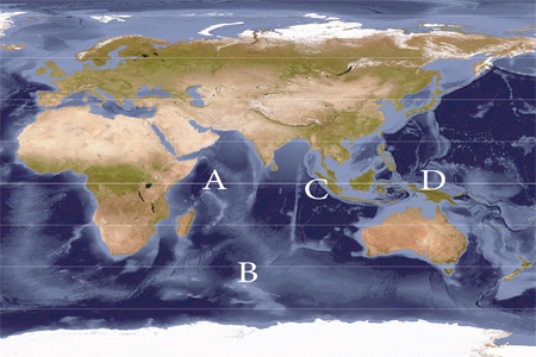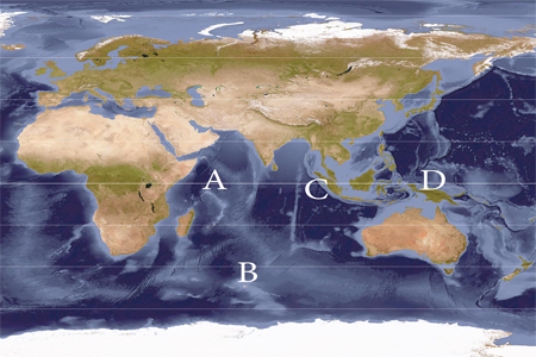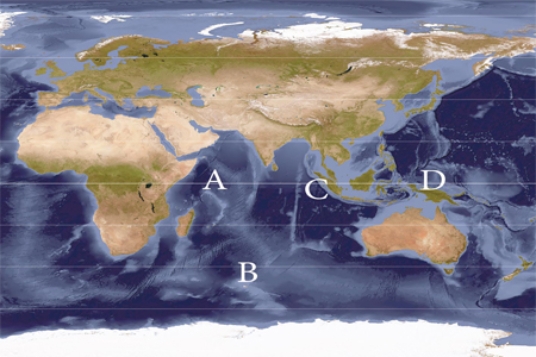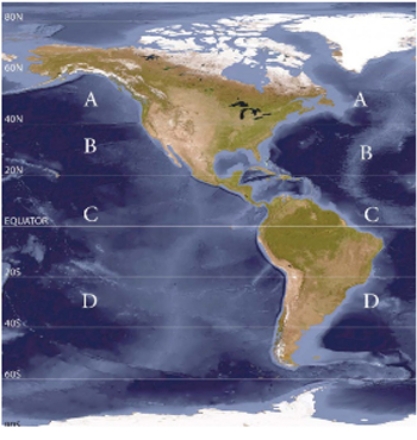A) A
B) B
C) C
D) D
Correct Answer

verified
Correct Answer
verified
Multiple Choice
The El Nino begins to weaken and eventually terminates when
A) the leading edge of the cold Kelvin wave finally reaches the eastern coast of South America.
B) cold water spreads out away from the equator, bringing warm upwelling waters from depth.
C) cold water converges on the equator, bringing cold upwelling waters from depth.
D) warm water spreads out away from the equator, bringing cold upwelling waters from depth.
Correct Answer

verified
Correct Answer
verified
Multiple Choice
Warm air rising from the fluctuating location of the warm pool becomes incorporated into
A) the westward moving Walker cell and eastward moving Hadley cell.
B) the eastward moving Walker cell and westward moving Hadley cell.
C) the westward moving subtropical and polar front jet streams.
D) the eastward moving subtropical and polar front jet streams.
Correct Answer

verified
Correct Answer
verified
Multiple Choice
Sea Surface Temperatures (SST) are warmest
A) where oceans are deepest allowing for sufficient mixing.
B) along the equator where the sun's rays are most direct.
C) at the subtropics because descending air promotes clear skies.
D) at the poles where long days during summer warm water.
Correct Answer

verified
Correct Answer
verified
Multiple Choice
The circulation of the Icelandic low pressure system which influences the North Atlantic Oscillation (NAO) is
A) clockwise and inward.
B) clockwise and outward.
C) counterclockwise and inward.
D) counterclockwise and outward.
Correct Answer

verified
Correct Answer
verified
Multiple Choice
Which of the following conditions would MOST cause water to rise to the surface?
A) warming freshwater
B) cooling freshwater
C) cooling saltwater
D) warming saltwater
Correct Answer

verified
Correct Answer
verified
Multiple Choice
A positive phase of the Indian Ocean Dipole (IOD) results in warmer than average surface waters at ______ and cooler than average waters at ___________. 
A) A; C
B) A; D
C) C; A
D) C; B
Correct Answer

verified
Correct Answer
verified
Multiple Choice
A strong negative index for the North Atlantic Oscillation (NAO) usually means that there is ________ of a pressure difference between the Bermuda (subtropical) high and the Icelandic low pressure.This brings _____________ than average temperatures over the northern U.S. And northwest Europe
A) less, cooler.
B) less, warmer.
C) greater, cooler.
D) greater, warmer.
Correct Answer

verified
Correct Answer
verified
Multiple Choice
The distribution of warm pools can best be explained by warm
A) westward flowing water accumulating on the western side of landmasses.
B) eastward flowing water accumulating on the western side of landmasses.
C) eastward flowing water accumulating on the eastern side of landmasses.
D) westward flowing water accumulating on the eastern side of landmasses.
Correct Answer

verified
Correct Answer
verified
Multiple Choice
The rain-shadow effect on the Isthmus is most pronounced
A) in the summer, on the Pacific side of the Isthmus.
B) in the winter, on the Pacific side of the Isthmus..
C) in the winter, on both sides of the coasts of the Isthmus
D) in the winter, on both sides of the coasts of the Isthmus,
Correct Answer

verified
Correct Answer
verified
Multiple Choice
In regard to the Indian Ocean Dipole (IOD) is air mainly descending at ____, and rising at ___. 
A) A; C
B) A; D
C) C; A
D) C; B
Correct Answer

verified
Correct Answer
verified
Multiple Choice
A cross section of the ocean from its surface to the seafloor shows
A) less dense, colder water overlying less dense, warmer water.
B) more dense, warm water overlying less dense, colder water.
C) less dense, warmer water overlying denser, colder water.
D) more dense, warmer water overlying denser, colder water.
Correct Answer

verified
Correct Answer
verified
Multiple Choice
A negative phase of the Indian Ocean Dipole (IOD) results in warmer than average surface waters at ______ and cooler than average waters at ___________. 
A) A; C
B) A; D
C) C; A
D) C; B
Correct Answer

verified
Correct Answer
verified
Multiple Choice
The air above this current is characterized by extremely strong pressure gradients and relative lack of land interruptions which induce extremely strong westerly winds.
A) California Current
B) Gulf Stream
C) Antarctic Circumpolar Current
D) North Equatorial Current
Correct Answer

verified
Correct Answer
verified
Multiple Choice
A Kelvin wave develops when:
A) westward moving winds weaken causing the mound of warm water in the western Pacific to move eastward.
B) eastward moving winds weaken causing the mound of warm water in the western Pacific to move eastward.
C) westward moving winds strengthen causing the mound of warm water in the western Pacific to move eastward.
D) westward moving winds weaken causing the mound of warm water in the western Pacific to move westward.
Correct Answer

verified
Correct Answer
verified
Multiple Choice
Where on the map is the center of high pressure influencing ocean currents with a counterclockwise circulation? 
A) A
B) B
C) C
D) D
Correct Answer

verified
Correct Answer
verified
Multiple Choice
Which of the following statements about water is true?
A) At temperatures above 4°C, warmer water will rise.
B) At temperatures above 4C, warmer water will sink.
C) At temperatures between 0°C and 4°C, warmer water will rise.
D) At temperatures below 0°C, warmer water will sink.
Correct Answer

verified
Correct Answer
verified
Multiple Choice
Water's salinity can be increased by
A) entering freshwater streams.
B) decreased rates of evaporation.
C) ice freezing.
D) ice melting.
Correct Answer

verified
Correct Answer
verified
Multiple Choice
Subtropical waters are typically more saline than equatorial waters because of
A) low evaporation, high precipitation.
B) low evaporation, low precipitation.
C) high evaporation, low precipitation.
D) high evaporation, high precipitation.
Correct Answer

verified
Correct Answer
verified
Multiple Choice
An El Nino is fully in place when:
A) as dispersing water spreads away from the equator on the eastern coast of South America.
B) as dispersing water spreads away from the equator on the western coast of South America.
C) the leading edge of the Kelvin wave reaches the western coast of South America.
D) the leading edge of the Kelvin wave reaches the eastern coast of South America.
Correct Answer

verified
Correct Answer
verified
Showing 41 - 60 of 70
Related Exams